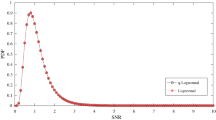Abstract
The rise of the need of fading radio channel simulators is due to time and cost of field tests of wireless communications systems. Growth in the demand for fixed wireless access increases the need for wide area system modeling. There exist two approaches to design a hardware based fading simulators, namely the filter based and sum of sinusoids (SOS) methods . This paper introduces a hardware based Ricean fading simulator that is based on SOS and utilizes empirical formulas that were derived based on extensive measurements to estimate the Ricean distribution K factor characterizing outdoor suburban and rural environments. The simulator presented here can simulate the Ricean fading radio channel under different parameters including antenna height, antenna beamwidth, season and distance between the transmitter and the receiver. Our experiments demonstrate that 8 channels are sufficient to accurately emulate a multipath environment.










Similar content being viewed by others
References
Rice, S. O. (1944). Mathematical analysis of random noise. Bell System Technical Journal, 23, 282–332.
Alimohammad, A., & Cockburn, B. F. (2008). Modeling and hardware implementation aspects of fading channel simulators. IEEE Transaction on Vehicular Technology, 57(4), 2055–2069.
Patzold, M., Garcia, R., & Laue, F. (2002). Design of high-speed simulation models for mobile fading channels by using table look-up techniques. IEEE Transaction on Vehicular Technology, 49(4), 1178–1190.
A prototype architecture for the accurate modeling of Rayleigh fading waveforms. Proceeding of the 2003 Joint Conference of the Fourth International Conference on Information, Communication and Signal Processing 2003 and the Fourth Pacific Rim Conference on Multimedia, vol. 2, 1101–1105 (2003).
Salkintzis, A. K. (1999). Implementation of a digital wide-band mobile channel simulator. IEEE Transcation on Broadcasting, 45(1), 122–128.
Komninakis, C. (2003). A fast and accurate Rayleigh fading simulator. IEEE GLOBECOM, 6, 3306–3310.
Arrendondo, G. A., Chriss, W. H., & Walker, E. H. (1973). A multipath fading simulator for mobile radio. IEEE Transactions on Communications, 23(11), 1325–1328.
Casas, E., & Leung, C. (1990). A simple digital fading simulator for mobile radio. IEEE Transcation on Vehicular Technology, 39(3), 205–212.
Cullen, P. J., Fannin, P. C., & Swords, S. S. (1991). DSP implementation of a wideband frequency selective fading simulator. Antennas and Propagation, 1991. ICAP 91, Seventh International Conference on (IEE) (Vol. 1, pp. 492–495).
An, J. F., Turkmani, A. M., & Parson, J. D. (1990). Implementation of a DSP-based frequency non-selective fading simulator. Radio Receivers and Associated Systems, 1989, Fifth International Conference on (pp. 20–24),
Fard, S. F., Alimohammad, A., & Cockburn, B. F. (2010). An FPGA based simulator for high path count Rayleigh and Rician fading. IEEE Transaction on Vehicular Technology, 59(6), 2725–2734.
Alimohammad, A., Fard, S. F., Cockburn, B. F., & Schlegel, C. A. (2008). A compact single-FPGA fading-channel simulator. Transcations on Circuits and Systems II: Express Briefs, 55, 84–88.
Marzetta, T. L. (1995). EM algorithm for estimating the parameters of a multivariate complex Rician density for polarimetric SAR. 1995 International Conference on Acoustics, Speech and Signal Processing (vol. 5, pp. 3651–3654).
Chen, Y., & Beaulieu, N. C. (2005). Maximum likelihood estimation of the K factor in Ricean fading channels. IEEE Communications Letters, 9, 1040–1042.
Greenstein, L. J., Michelson, D. G., & Erceg, V. (1999). Moment-method estimation of the Ricean K-factor. IEEE Communications Letters, 3(6), 1089–7789.
Greenstein, L. J., Ghassemzadeh, S. S., Erceg, V., & Michelson, D. G. (2009). Ricean K-factors in narrow-band fixed wireless channels: Theory, experiments, and statistical models. IEEE Transcations on Vehicular Technology, 58(8), 4000–4012.
Feick, R., Valenzuela, R. A., & Ahumada, L. (2007). Experimental results on the level crossing rate and average fade duration for urban fixed wireless channels. IEEE Transcations on Wireless Communications, 6(1), 175–179.
Author information
Authors and Affiliations
Corresponding author
Rights and permissions
About this article
Cite this article
Badawy, A., Wolff, R. A Hardware Based Ricean Fading Radio Channel Simulator. Wireless Pers Commun 93, 615–627 (2017). https://doi.org/10.1007/s11277-014-2217-x
Published:
Issue Date:
DOI: https://doi.org/10.1007/s11277-014-2217-x




